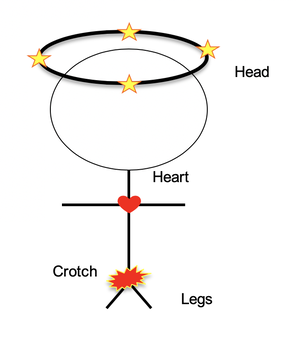Thinking About Narrative: A Fresh Take On The Essentials
During my second year at Mason’s MFA program, I took a workshop with Tania James who had recently done a Q+A with Hannah Tinti about what she looks for when she is accepting submissions for One Story. Tania shared the details of the Q+A with us and this, in turn, led to a larger discussion about narrative. While Tinti likes the basic narrative structure, she has put her own fresh spin on it. The narrative "structure" Tinti uses to assess the stories she reads and the ones that she writes looks something like this:
Legs. If your story doesn't have a sturdy pair of legs to stand on it will crumble. Think of this as your exposition. This is the part of the story where you are introducing your character(s), your world, and laying the groundwork for the story to come.
Crotch. This is where things start to get spicy - and complicated. It's the moment where conflicts start to get messy and readers start to see what makes your story unique. This is what I like to call "the X-Factor."
Heart. While the crotch may intrigue your reader, the heart is what sells your reader. It's the emotional core of your story. Understanding what drives your character(s) and makes them vulnerable is something I cannot stress enough because this is what causes your readers to become wholeheartedly invested in them.
Head. The head represents the end of your story. You'll notice my stick figure is seeing stars. Those stars are what you are shooting for. When your story ends, you want your readers to feel as if they are in a daze, like they have just woken up from a wild dream, and they are desperate to linger in it for as long as they can.
What I like about this diagram is that it challenges me to think about my story from a reader’s perspective. Readers might not know the difference between exposition or falling action, but they will subconsciously know if your story has two legs to stand on. They will care about whether or not the plot is unique and the characters are emotionally vulnerable.
But while I believe this diagram is useful, I don't believe it is for everyone. Nor do I believe it is essential to keep in mind while you are writing your story. When writing, keep it simple. Stick to the basic diagram. But when it comes time to edit, take a step back and use Tinti's diagram to put yourself in your reader's shoes. Evaluating your story in this way may help you figure out where your story needs work and how you can develop it.



